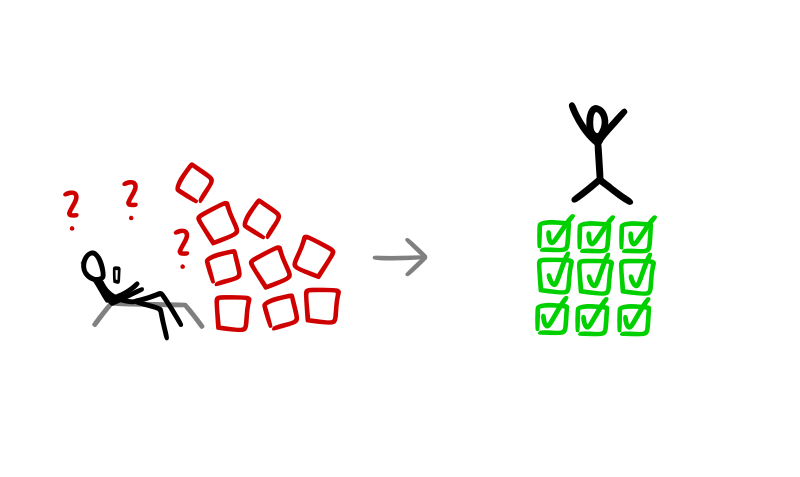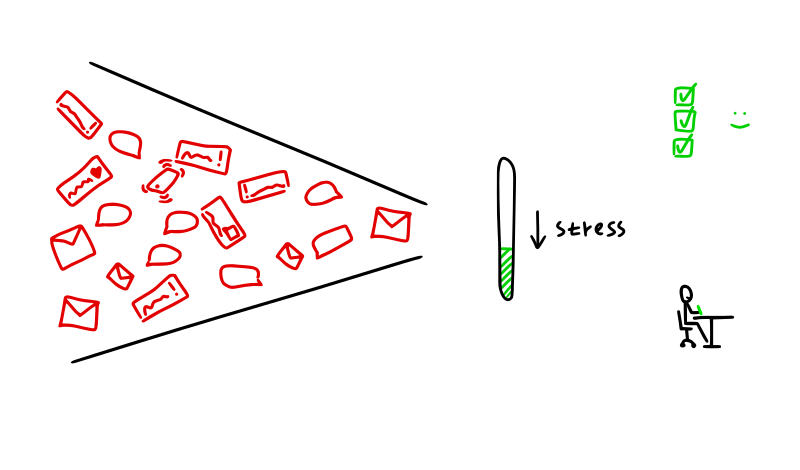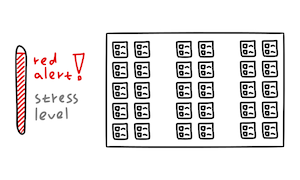How to get out of a slump and restart good habits

Not exercising? Not meditating? Not eating healthy? You're not alone. There's a billion things we could all do for our physical and mental health. But who has time to do them all?
A lot of us have good periods in life and we have worse periods that you might call slumps. If you're currently in a bit of a slump, this is the post for you.
We'll give you a couple practical tips to reset and go back to doing things that make you feel good about yourself, instead of undermining your sense of self-worth.
You probably did have some good habits in the past, but then life happened. And now, your routines and habits are perhaps not so good anymore. So what to do about this? How to restart and resume past good habits? How to get back on track?
Step #1: Face the numbers
The first step is deceptively simple: face the numbers.
For most things in life, there exists a number that serves as an indicator of how well you're doing. That number can be motivating or demotivating. Of course, if you're in a slump, you'll be tempted to avoid looking at that number because you know it will make you feel some negative emotions.
Maybe you feel upset because the number on a scale is higher than you'd like.Maybe you feel upset because the word count in your thesis document seems to be stuck at 0.Maybe you feel upset because the numbers in your bank account seem to be going only in one direction.
Facing those numbers is unpleasant, yes, but that is what you need to do. It might make you feel upset, but that's not always unhelpful. Negative emotions exist for a reason. Negative emotions exist to help us crystallize our discontent and actually make a change.
Unfortunately, many people now have a habit of running away from any sort of negative emotion. Not feeling content? Consume content on social media for 2 hours!
So the first step is obvious:
Face the numbers instead of avoiding it.
And here's the thing to realize...
0 is the start
It's not pleasant, but acknowledging the fact that you're at 0 is the beginning of approaching, instead of avoiding.
0 is the start, not the end.
0 minutes. 0 words. 0 pull-ups.
We all start at 0, the point is not to stay there.
The sooner you move from 0, the better you'll feel.
The more frequently you go from 0 to > 0, the more self-confidence you'll feel overall, because every time you do something instead of nothing, you'll improve your self-image a bit.
If you consistently do > 0 day after day after day, you can't help but feel more confident about your ability to follow through.
So when you're at 0, don't judge yourself. That's the starting position. Every time you find yourself at 0, focus on moving from there as soon as you can.
Put the 0 where you'll see it
You might be nodding along in your head: I get it, acknowledge the 0. Move from it ASAP. Okay.
But as with a lot of advice, it's easy to maybe use it for a day or 2 and then conveniently forget.
Here's a strategic tip to help you in the long-term:
Use your environment to remind you of the things you wanted to do.
In the context of this post, it means putting the 0 where you'll see it.
Put a piece of paper on your fridge.Make yesterday's daily step count your phone background.Pin a spreadsheet with "Time spent working" as the 1st tab in your browser.
Crucially, update that number when it's not 0 anymore. Every time you make that number go up (cross out 0, put 10 there, change the number in the spreadsheet...), you'll feel a little boost of dopamine, signaling that you're on the right path. (This is an example of good dopamine release, as opposed to bad dopamine release you get by checking notifications.)
Put the number that matters somewhere where you'll see it daily, and if you do > 0 update that number on your counter.
Embrace the 0 every morning and move from 0 as soon as you can.
Non-zeros build self-confidence
We've written about non-zero days before—every day that you do something instead of nothing will boost your self-confidence and ability to trust in yourself.
That self-confidence will in turn help you tackle bigger tasks, which will boost your self-confidence even more, and then you'll procrastinate less because everything will be much less intimidating.
Now before we let you go, here's one more piece of advice :
Pick just one activity at first. Don't try to change 5 0s into 100s at once. Pick one area of your life that would make you feel good if you finally went from 0 to 5 or 10.
This way you don't fall into the usual trap of checking off all the boxes for 3 days, then failing, and returning back to old habits, feeling even less confident in your ability to change yourself.
Summary
To sum it all up:
- Pick 1 area of your life that you want to improve (fitness, work ethic, etc)
- Acknowledge where you are: at 0.
- Put the 0 where you'll see it.
- Move from 0 as soon as you can (& update the number)
- Repeat daily
That's how you start overcoming procrastination for a specific area of your life.



